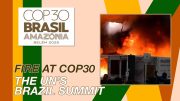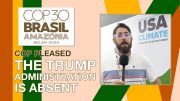“There are ominous signs that the earth’s weather patterns have begun to change dramatically and that these changes may portend a drastic decline in food production — with serious political implications for just about every nation on earth. The drop in food output could begin quite soon, perhaps only ten years from now.”
Newsweek published this dire warning in its April 28, 1975 issue, years before global warming began getting the headlines it does today. The article continued: “The evidence in support of these predictions has now begun to accumulate so massively that meteorologists are hard pressed to keep up with it. In England, farmers have seen their growing season decline by about two weeks since 1950, with a resultant over-all loss in grain production estimated at up to 100,000 tons annually. During the same time, the average temperature around the equator has risen by a fraction of a degree — a fraction that in some areas can mean drought and desolation. Last April, in the most devastating outbreak of tornadoes ever recorded, 148 twisters killed more than 300 people and caused half a billion dollars’ worth of damage in thirteen U.S. states.”
Were the editors at Newsweek clairvoyant? Based upon evidence — from shorter growing seasons, to increasing temperatures around the equator, to more extreme weather — did Newsweek accurately forecast the coming of global warming more than 30 years ago? Well, no. Though Newsweek did report at the time that “to scientists, these seemingly disparate incidents represent the advance signs of fundamental changes in the world’s weather,” they were not forecasting global warming. In an article entitled “The Cooling World,” Newsweek warned: “The central fact is that after three quarters of a century of extraordinarily mild conditions, the earth’s climate seems to be cooling down.”
Newsweek was not the only publication to warn about the supposed threat of global cooling during the 1970s. In an article entitled “Another Ice Age?” the June 24, 1974 issue of Time reported: “However widely the weather varies from place to place and time to time, when meteorologists take an average of temperatures around the globe they find that the atmosphere has been growing gradually cooler for the past three decades.” Indeed, the average global temperature had been falling since about 1940, a trend that did not change until about 1975. When this article appeared in 1974, the mean global temperature had fallen about 2.7 degrees F since the 1940s.
However, Time’s “Another Ice Age?” article did not predict a break in this decades-long cooling trend. Just the opposite, in fact. “The trend shows no indication of reversing,” Time warned. “Climatological Cassandras are becoming increasingly apprehensive, for the weather aberrations they are studying may be the harbinger of another ice age.”
The article continued: “Telltale signs are everywhere — from the unexpected persistence and thickness of pack ice in the waters around Iceland to the southward migration of a warmth-loving creature like the armadillo from the Midwest.”
Fortune magazine, too, gave warning. A February 1974 article, entitled “Ominous Changes in the World’s Weather,” claimed that “there’s fair agreement among researchers that the earth is now heading very slowly into another major ice age such as the one that brought the glaciers deep into North America before it retreated some 10,000 years ago.” This article also pointed to the supposedly unusual weather patterns of the day as harbingers of much worse to come: “Climatologists now blame those recurring droughts and floods on a global cooling trend. It could bring massive tragedies for mankind.”
Scientific Opinion
What climatologists? All three articles quoted above cited Reid Bryson, then director of the Institute for Environmental Studies at the University of Wisconsin. That’s not surprising, since Bryson was considered one of the most important climatologists of his day. “There is very important climatic change going on right now,” Fortune quoted Bryson as saying. “It is something that, if it continues, will affect the whole human occupation of the earth — like a billion people starving. The effects are already showing up in rather drastic ways.”
Bryson argued that an increasing density of small dust particles (also known as aerosols) in the atmosphere was adding to the Earth’s albedo. That is, it was causing a larger percentage of the sun’s light to be reflected back into space. He also believed that the cooling effect of the increasingly dense dust covering had become so great that it started overpowering the warming effect of atmospheric carbon dioxide, ending a warming trend that lasted until about 1940 and ushering in global cooling.
Other climatologists who agreed with Bryson’s assessment included S.I. Rasool and Stephen H. Schneider at NASA’s Goddard Space Flight Center. In an article in the July 9, 1971 issue of Science, entitled “Atmospheric Carbon Dioxide and Aerosols: Effects of Large Increases on Global Climate,” Rasool and Schneider concluded that a large increase of dust particles in the atmosphere would have a much greater impact on the global climate than a large increase of carbon dioxide.
Hmm, why did Rasool and Schneider believe that the concentration of atmospheric dust particles could increase this radically? Not surprisingly, they pointed to man. They warned: “It is projected that man’s potential to pollute will increase six- to eightfold in the next 50 years” — an amount they believed could increase the Earth’s overall dust concentration sufficiently to cause an ice age.
Though there was disagreement at the time as to whether the Earth was cooling, and if it was cooling how much of the cooling, if any, was attributable to man’s activities, Rasool and Schneider were not alone in viewing man as a culprit. Bryson too teared that man’s impact on the global climate was becoming increasingly significant. As the June 24, 1974 issue of Time stated: “The University of Wisconsin’s Reid A. Bryson and other climatologists suggest that dust and other particles released into the atmosphere as a result of farming and fuel burning may be blocking more and more sunlight from reaching and heating the surface of the earth.”
Of course, other factors besides man were at play, such as other particles making their way into the atmosphere coming from natural sources such as volcanoes. The key question was: Would man’s own “contribution” to the blanket of atmospheric particles surrounding the Earth truly make an appreciable difference on the global climate? Regardless of the possible factors at play during the global temperature drop from about 1940 to about 1975, there is no question that the temperature did drop.
The November 1976 issue of National Geographic, in an article entitled “What’s Happening to Our Climate?” quoted the U.S. National Science Board as saying two years earlier, “During the last 20 to 30 years, world temperature has fallen, irregularly at first but more sharply over the last decade.” But the same article also acknowledged that though “most scientists agree that today’s ice movement may reflect a worldwide cooling trend … their explanations vary widely.”
One scientist who detected advancing ice movement during the 1970s was climatologist George J. Kukla of Columbia University. As Time reported in its “Another Ice Age?” article, when Kukla “and his wife Helena analyzed satellite weather data for the Northern Hemisphere, they found that the area of the ice and snow cover had suddenly increased by 12% in 1971 and the increase has persisted ever since. Areas of Baffin Island in the Canadian Arctic, for example, were once totally free of any snow in summer; now they are covered year round.”
Some climatologists were so concerned about global cooling and advancing ice that they believed governments needed to intervene to combat the trend. But they were not optimistic. Newsweek’s 1975 “The Cooling World” article reported: “Climatologists are pessimistic that political leaders will take any positive action to compensate for the climate change, or even to allay its effects. They concede that some of the more spectacular solutions proposed, such as melting the arctic ice cap by covering it with black soot or diverting arctic rivers might create problems far greater than those they solve. But the scientists see few signs that government leaders anywhere are even prepared to take the simple measures of stockpiling food or of introducing the variables of climate uncertainty into economic projections of future food supplies.”
The Newsweek article concluded: “The longer the planners delay, the more difficult will they find it to cope with climatic change once the results become grim reality.”
Then and Now
These days, of course, we no longer hear much if anything at all about the possibility of runaway global cooling triggering another ice age. Instead, we hear a lot about the threat of catastrophic global warming. We hear so much about it, in fact, that today’s headlines about global warming undoubtedly dwarf the media attention given to global cooling in the 1970s.
What happened? Well, one thing that happened is that the temperature trend changed. After dropping for about 35 years, the temperature started going up again in the mid 1970s, though the global temperature now is only slighter higher than it was in 1940 when the cooling trend began.
Over the centuries and millennia the weather has changed, at times radically. Those changes included the ice age, when advancing glaciers covered much of the northern United States. They also included the “little ice age” beginning in the 15th century. Prior to that time, according to the 1974 Fortune article quoted above, “grapes were widely cultivated in England, and the French complained of English wine makers dumping their wares in European markets. As early as the tenth century, the Vikings had established prosperous colonies in Greenland, having named the island for its verdant pastures. By the early fifteenth century, however, these colonies were wiped out by cold and hunger and now four-fifths of Greenland lies buried under hundreds of feet of ice cap.”
Obviously nobody — at least nobody we know of! — blames man’s activities on Earth for either the ice age or the little ice age. But in the 1970s some experts argued that man’s impact on his environment had grown to the point where his atmospheric pollutants were contributing significantly to global cooling, just as some experts now argue that his CO2 and other “greenhouse” gas emissions are causing global warming.
One of these scientists is Dr. Stephen Schneider, the coauthor of the Science report cited above, who in the 1970s was worried about the threat of global cooling. Now at Stanford University, Dr. Schneider not only sees things differently but is considered one of the leading experts sounding the alarm about global warming.
In an MSNBC report on January 9 of this year, Schneider argued that today’s warming trend “has been induced by humans using the atmosphere as a free place to dump our tailpipe waste.” Regarding extreme weather such as droughts and hurricanes, Schneider acknowledged that “we all know that humans don’t make hurricanes.” But he added: “Katrina was not produced by global warming, yet Katrina was a little stronger because it went over an ocean that was half a degree warmer than it would have been.”
Obviously, if Schneider is right now then he had to be wrong in the 1970s. But is he right now? The fact that so many experts were wrong in the ’70s does not necessarily mean that they are wrong today. But it does at least show that the experts are sometimes incredibly wrong.
Some of them anyway. Not everybody sounded the alarm about global cooling in the 1970s, and not everybody is sounding the alarm about global warming today. There are in fact many reputable scientists who simply do not buy the theory of man-induced, catastrophic global warming, including Dr. Richard Lindzen of MIT, Dr. William Gray of Colorado State University, and Dr. Timothy Ball, chairman of the Natural Resources Stewardship Project in Canada. In fact, 17,000 scientists, two-thirds of them with advanced degrees, signed a petition urging the U.S. government “to reject the global warming agreement that was written in Kyoto … and any other similar proposals.” But these are not the experts the major media usually refer to in their global-warming coverage, and when the media do refer to them they are usually referred to as global warming “skeptics” as if to suggest they are outside the mainstream of scientific thought.
Media depictions to the contrary, there is no climate-change consensus within the scientific community — either now or in the 1970s.
(This article originally appeared under the title “Weather Forecast: Doom.”)




